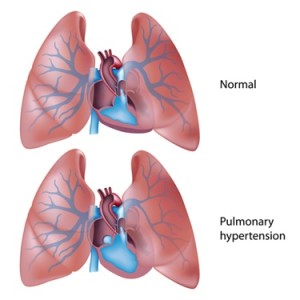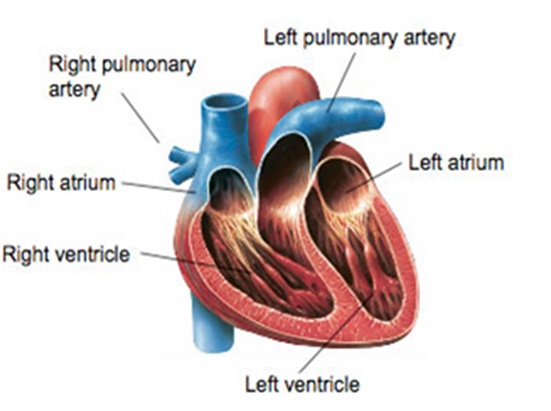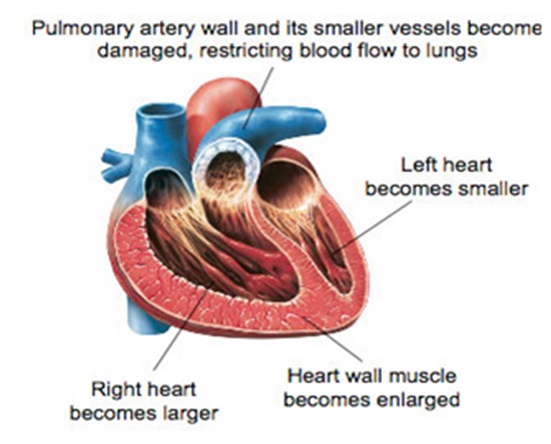Definition and Overview
What is Pulmonary Hypertension?
Pulmonary Hypertension is sometimes known as ‘the other hypertension’. Most people are familiar with Hypertension – that means high blood pressure in the body. The word ‘pulmonary’ refers to the lungs. Therefore,
Pulmonary Hypertension = High blood pressure in the lungs
Specifically, it is high blood pressure in the blood vessels of the lungs. This occurs when these blood vessels are narrowed or obstructed, making blood unable to flow freely to and from the lungs.

Why is this important? Firstly, we know that the main – and extremely crucial – purpose of the lungs is to absorb oxygen (O2) and remove waste (in the form of carbon dioxide, CO2). Without O2, nothing in our body would be able to function.
How this occurs is through a transport system, known as the pulmonary circulation. When blood passes through the lungs, carbon dioxide is picked up and replaced with oxygen. In PH, the blood vessels become stiff, damaged or narrowed, so the right side of the heart must work harder to pump blood through.

For a better understanding of how this happens, watch this informative video from the NHCS and SGH.


How rare is PH?
PH is estimated to affect 1% of the global population1. However, only those diagnosed with Group 1, 4 or 5 are considered rare (read next section for details). In Singapore, around 300 or more people are on PH-specific drugs – or approximately 1 in 18,000. More and more people may be diagnosed with PH because of early and improved testing processes.
Types of PH
PH is a complex disease and should be diagnosed by a specialist. Each form of PH is different and should be treated accordingly. The following outlines different types of PH1:
Group 1: Pulmonary arterial hypertension (PAH)
This type of PH affects the smallest arteries, which are the blood vessels that carry blood from the heart to the lungs. This type of PH tends to affect younger women. Sub-types of PAH are Idiopathic PAH (cause is unknown) and Heritable PAH (runs in the family). Other causes of PAH are:
- drugs and toxins
- connective tissue disease
- HIV infection
- hypertension in the liver
- congenital heart diseases
- schistosomiasis (parasitic worm)
- PAH with features of venous/capillary (PVOD/PCH) involvement
- persistent PH of the newborn
Group 2: PH associated with left heart disease
As the name suggests, this type of PH occurs because of abnormal function or defects in the left side of the heart. Globally, this is the most common cause of PH. It usually affects older women. This group includes the conditions:
- heart failure
- valvular heart disease
- congenital/acquired cardiovascular conditions leading to post-capillary PH
Group 3: PH associated with lung diseases and/or hypoxia
This type of PH is a result of problems in the lung and/or low blood oxygen levels. Older men are usually affected, and those with history of smoking. This group includes the conditions:
- obstructive lung disease or emphysema, including chronic obstructive pulmonary disease (COPD)
- restrictive lung disease
- other lung diseases with mixed restrictive and obstructive pattern
- hypoventilation syndromes
- hypoxia without lung disease (e.g.) high altitude
- developmental lung disorders
Group 4: PH associated with pulmonary artery obstructions
This occurs when clots or clumps, usually blood or other substances, form and travel to the lungs, where it prevents blood from flowing. This type of PH is especially difficult to diagnose because clots can form without you knowing it, until it causes symptoms severe enough for you to notice. It can occur in any age, but older men and women are equally affected.
- chronic thromboembolic pulmonary hypertension (CTEPH)
- other pulmonary artery obstructions
Group 5: PH with unclear and/or multifactorial mechanisms
These usually relate to other diseases where there may be many causes for the development of PH, and includes the conditions:
- hematologic disorders
- systemic disorders
- metabolic disorders
- chronic renal failure with or without haemodialysis
- pulmonary tumour thrombotic microangiopathy
- fibrosing mediastinitis
For a better understanding of the different types of PH, click here.
Signs & Symptoms of PH
How do I know I might have PH?
The symptoms of PH also occur in other more common lung conditions, hence it can be difficult to diagnose. Some signs and symptoms in PH are:
- breathlessness
- fatigue
- chest pain or discomfort
- light-headedness or fainting
- leg and ankle swelling
- palpitations (fast or irregular heartbeat)
- coughing up blood
- swelling and nausea during exercise
- central or peripheral cyanosis (blue discolouration in the lips or fingers/toes)
- voice hoarseness
These are just some signs seen in patients who have PH. Not all patients who have PH will have every symptom, and some may have symptoms not listed here.
I’m afraid I may have PH. What will the future hold for me?
Since PH is difficult to diagnose because it acts like other lung or heart diseases, the first step in successfully managing PH is to get diagnosed. Having the correct diagnosis allows the correct treatment to be started. Starting treatment as early as possible will provide better outcomes for you, such as your longevity. Shorter life expectancies are usually related to more severe symptoms and having other medical problems.
Reference:
1. Humbert M, Kovacs G, Hoeper MM, Badagliacca R, Berger RMF, Brida M, Carlsen J, Coats AJS, Escribano-Subias P, Ferrari P, Ferreira DS, Ghofrani HA, Giannakoulas G, Kiely DG, Mayer E, Meszaros G, Nagavci B, Olsson KM, Pepke-Zaba J, Quint JK, Rådegran G, Simonneau G, Sitbon O, Tonia T, Toshner M, Vachiery JL, Vonk Noordegraaf A, Delcroix M, Rosenkranz S; ESC/ERS Scientific Document Group. 2022 ESC/ERS Guidelines for the diagnosis and treatment of pulmonary hypertension. Eur Respir J. 2022 Aug 30:2200879. doi: 10.1183/13993003.00879-2022. Epub ahead of print. PMID: 36028254.
Feeling lost? Use the following to help you navigate medical terms:
All information here is intended to serve as a guide only, and does not replace consultation from a certified medical physician. Always speak to your doctor about the treatments and plans relating to your medical condition and the intended outcomes. All information is adapted from the Pulmonary Hypertension Association and the 2022 ESC/ERS Guidelines for the diagnosis and treatment of pulmonary hypertension unless otherwise stated.


